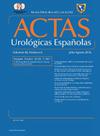对骨盆骨折性尿路损伤进行解剖式尿路成形术时保留球状动脉的结果
IF 1.2
4区 医学
Q3 UROLOGY & NEPHROLOGY
引用次数: 0
摘要
目的探讨保留血管入路在骨盆骨折尿道损伤(PFUI)重建中的远期疗效。材料和方法:PFUI的吻合重建不需要横切海绵体,以保持球动脉的顺行流动。暴露尿道后,用多普勒听诊器定位球动脉。球茎向背侧单侧移动,牺牲多普勒信号较弱的动脉以保留最佳对侧动脉。偶尔,两条动脉都可以保留。按照传统的横切技术切除所有的纤维化并进行吻合。结果共纳入60例患者,平均年龄37岁(IQR: 22-48)。从创伤到尿道重建的中位时间为16周,平均狭窄长度为2.5 cm (IQR: 2-3)。左侧球动脉保留27例,右侧球动脉保留8例,两者均保留24例。术后出现并发症14例(23%),但Clavien≥III级患者仅有1例。平均随访56个月(IQR: 12-87),仅有1例患者因狭窄而失败(成功率98%)。结论PFUI重建时保留海绵体顺行动脉血流是可行和安全的。虽然稍微复杂一些,但这项技术可以降低缺血性重建失败的风险。本文章由计算机程序翻译,如有差异,请以英文原文为准。
Resultado de la preservación de las arterias bulbares durante la uretroplastia anastomótica para la lesión uretral por fractura de pelvis
Objective
To the present long-term outcomes of the vascular-sparing approach during reconstruction of pelvic fracture urethral injuries (PFUI) described by Gomez et al.
Material and methods
Anastomotic reconstruction of PFUI is performed without transecting the bulb of the spongiosum, to preserve the antegrade flow of the bulbar arteries. After exposure of the urethra, the bulbar arteries are located using a Doppler stethoscope. The bulb is mobilized dorsally and unilaterally, sacrificing the artery with the weaker Doppler signal to preserve the best contralateral artery. Occasionally, both arteries can be preserved. Removal of all fibrosis and anastomosis is performed as described in the traditional transecting technique.
Results
A total of 60 patients were included, with a mean age of 37 years (IQR: 22-48). The median time from trauma to urethral reconstruction was 16 weeks, and the mean stenosis length was 2.5 cm (IQR: 2-3). The left bulbar artery was preserved in 27 cases, the right bulbar artery in 8, and both in 24. There were postoperative complications in 14 cases (23%), but only one of them was Clavien ≥ III. With a mean follow-up of 56 months (IQR: 12-87), only one patient failed due to stenosis (98% success).
Conclusion
Preservation of antegrade arterial flow to the corpus spongiosum during PFUI reconstruction is feasible and safe. Although slightly more elaborate, this technique could reduce the risk of ischemic failure of reconstruction.
求助全文
通过发布文献求助,成功后即可免费获取论文全文。
去求助
来源期刊

Actas urologicas espanolas
UROLOGY & NEPHROLOGY-
CiteScore
1.90
自引率
0.00%
发文量
98
审稿时长
46 days
期刊介绍:
Actas Urológicas Españolas is an international journal dedicated to urological diseases and renal transplant. It has been the official publication of the Spanish Urology Association since 1974 and of the American Urology Confederation since 2008. Its articles cover all aspects related to urology.
Actas Urológicas Españolas, governed by the peer review system (double blinded), is published online in Spanish and English. Consequently, manuscripts may be sent in Spanish or English and bidirectional free cost translation will be provided.
 求助内容:
求助内容: 应助结果提醒方式:
应助结果提醒方式:


